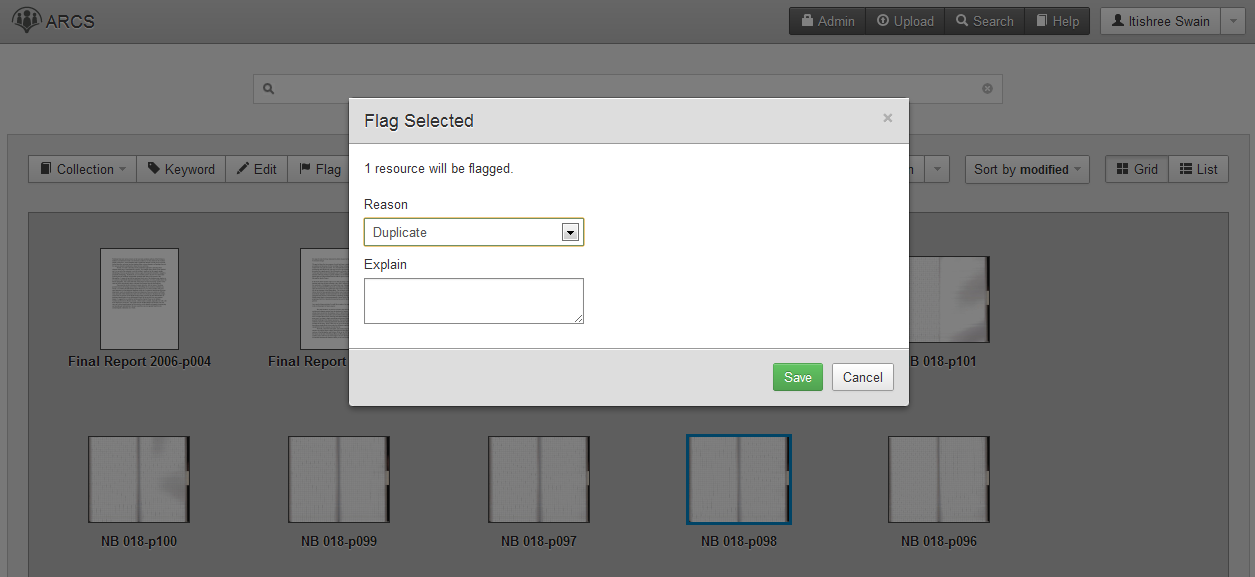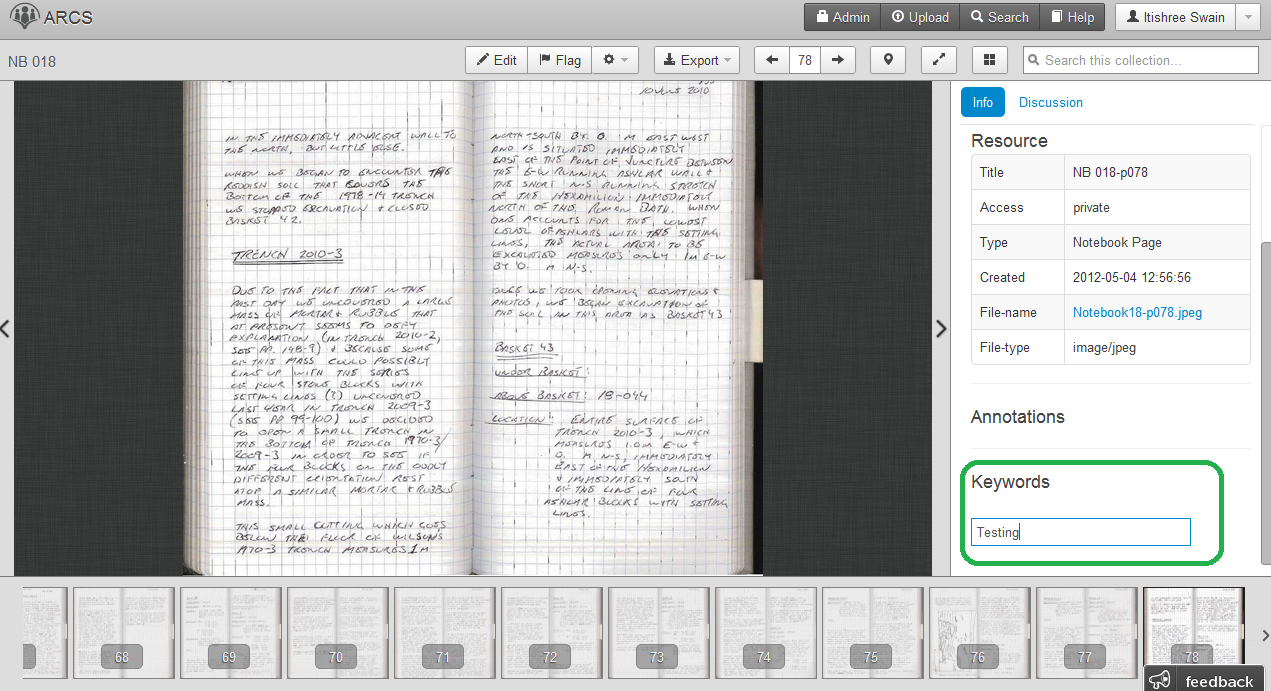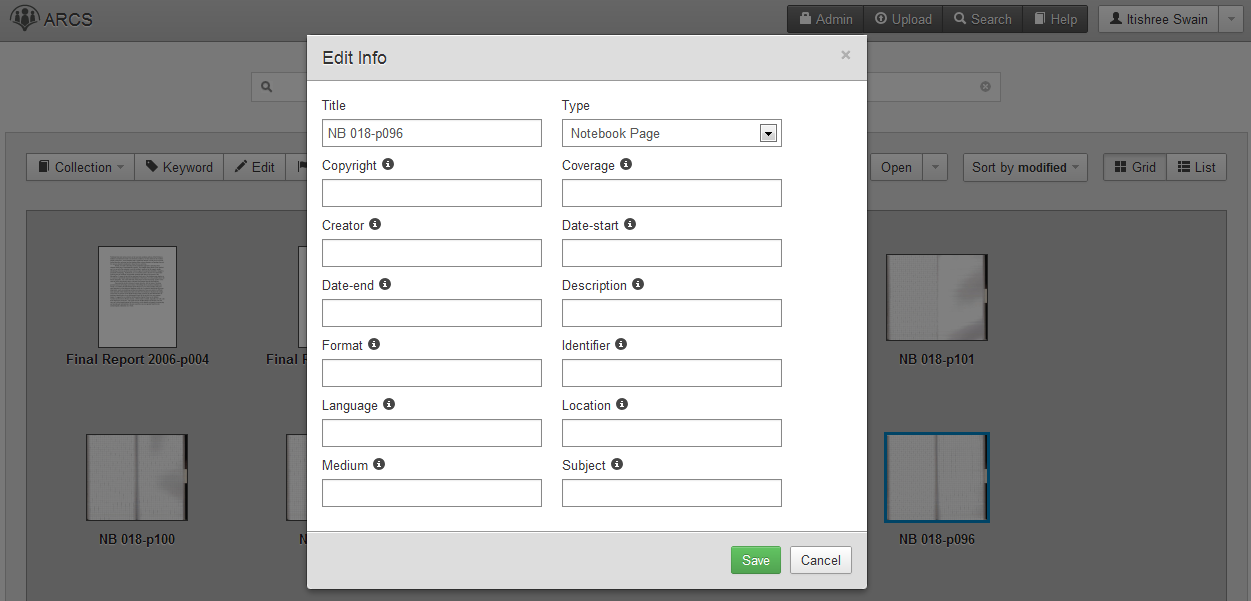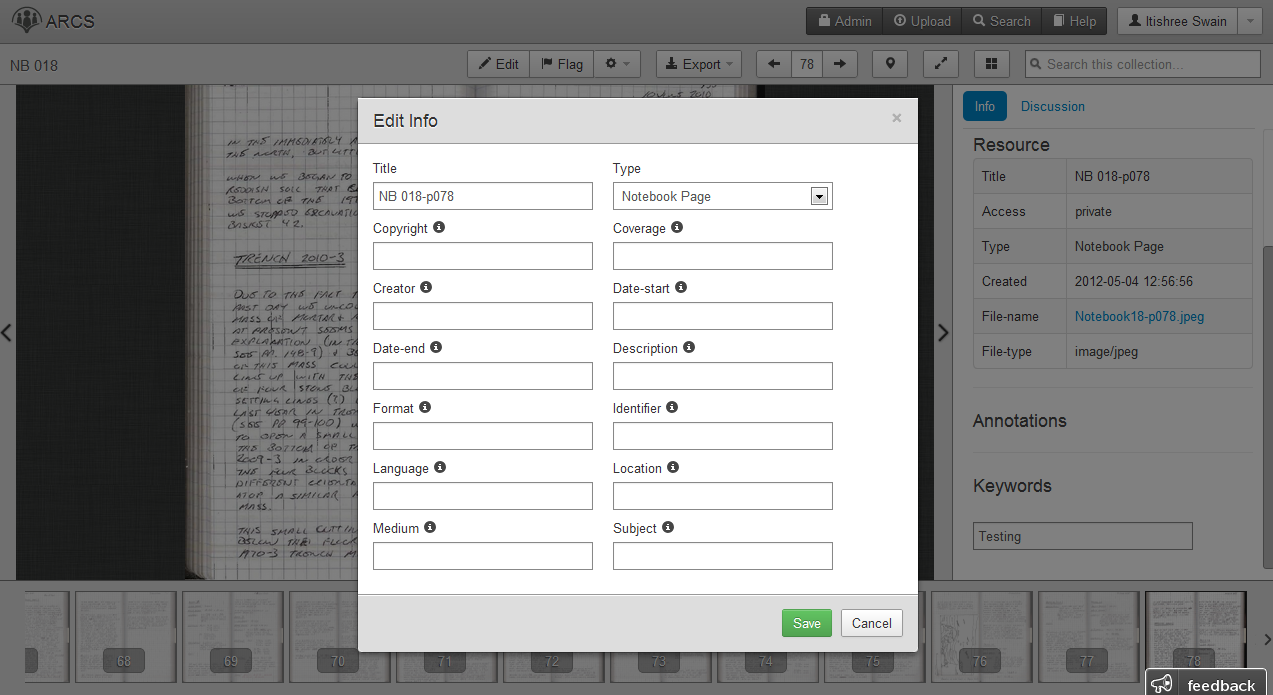Resources
Understanding Resources
In ARCS, a resource is defined as a digital representation of a single physical piece in a research collection. ARCS keeps quite a lot of data for each resource. For Isthmia, resources can have several different types like Notebook Pages, Photographs, Inventory Cards, Maps, Drawings, Reports etc.
Notebook Pages are page spreads of a Notebook. They’re seen within the context of the notebook they are a part of. They tend to contain handwritten field notes and reports, pasted photographs, sketches of significant areas and artifacts, and sketches of maps.

Photographs have two types: Scene and Object.
Scenes are establishing shots of a given area giving its context. Many times, scene photographs document trenches. These become helpful when you relate them to one of the maps drawn in the notebooks.

Object photographs are photographs of noteworthy artifacts. These are usually taken in a studio environment against a black background.

Inventory Cards are Isthmia’s way of keeping track of the artifacts archaeologists pull out of the dig. They document the size, shape, significance and any other archival data of an artifact. These cards generally hold a pasted photograph and/or a detailed sketch of the artifact, and on the back is an annotated bibliography of articles featuring that artifact.
Maps are maps of areas at the Isthmia dig. Generally these maps are either CAD or otherwise vectored drawings of anything from trenches to areas of the dig to the whole dig site.
Reports are weekly and yearly accounts of the happenings at the dig. These are generally typed documents without drawings for photographs. They do, however, include references to artifacts, photographs and areas of a dig that can be related to inventory cards and maps.

Working with Resources
There are various ways through which you can interact with any resource. You can work on a resource in the viewer or in the search page.
The Viewer
The Viewer is the central place where you can interact with a resource. You can see a high-resolution version of the resource, view its attributes, annotate it, view and add keywords, read and contribute to the discussion, and see the resource in the context of a collection. This can be found in the Viewer sidebar as shown below:

The Viewer toolbar is where you can edit resource attributes, flag a resource if you have a problem search within its main collection.
The Resource pool holds a big view of the resource.
The Sidebar enables you to see all the attributes for a parent collection as well as for the resource, all of the annotations, and keywords for a resource. In the discussion tab, you can talk about the resource, its problems or comments you might want to make about the resource.
If you’re in a collection, you will also see the collection carousel at the bottom that shows your resource in the context of the collection, whether it be a research collection, or a book type.
Discussion
Discussions are comments researchers make expressing opinions or asking questions about a resource in the viewer. These are different from annotations since they don’t declare factual information about the resource.
Adding a discussion is as simple as clicking on the discussion tab, typing your message, and clicking ‘Comment’.
You can review your discussions from your account page under the discussions
tab > Reviewing your discussions.
Search
The resources can also be seen as a grid pattern or can be enlisted in the search page as shown below:
Grid

List

Uploading Resources
Add new resources to ARCS by using the uploader. For more on that, check out our Uploading section.
Editing Resources
A resource can be edited in the following ways:
Flagging
Flagging is a way of reporting an issue with a resource when you don't have the permissions, information, or time to fix it yourself but which according to you requires attention and needs to be fixed. A resource should be flagged if there is an improper annotation, keyword or attribute etc.
A resource can be flagged by a Researcher, Sr. Researcher or the Administrator. Once you select a resource in the search page or in the viewer, you should select a reason for flagging from the drop down and also explain why you are flagging the resource with a specific feedback because they only have the information you give them in your flag.
You can flag a resource from either the search page or the viewer itself as shown below:
Search

Viewer

Keywording
Keywords (aka labels or tags) signify shared characteristics about resources. They can be assigned either to a resource or a group of resources. They are meant to give information about what a certain resource is about that isn’t covered by an annotation or in the attributes. A common keyword would be a trench mentioned in a notebook page.
Keywords are used in searching to make data mining resources easier. Therefore it is essential that keywords are used consistently so that researchers can pull all relevant resources with one query.
Search
You can assign keywords in the search page by selecting a resource or multiple
resources and then clicking on Keyword. You will see the following dialogue
where you can enter the keyword:

Viewer
You can also assign keywords in the viewer by just entering the keyword for the corresponding resource in the right-hand bottom corner box given as shown below:

Attributes
Attributes are pieces of data that ARCS stores about a resource. This includes its title, its unique identifier, its type, date created etc. and it can be edited from either the search page or the viewer.
As a researcher, you can edit the attributes to files you have created, and as an Administrator or a Sr Researcher, you can edit attributes to anything in your iteration of ARCS.
Search
If you have to edit any information regarding your own resource, you can do by
just selecting the resource and going into the Edit tab or by using Ctrl+E.
You can then edit the information regarding your resource as follows and save
it as shown below:

Viewer
You can also edit information for a specific resource from the viewer by
clicking on the Edit or by using Ctrl+E and then save it as shown below:

Annotating Resources
Annotations are intended for factual data on a resource. You can annotate any resource on the viewer. Any resource can be annotated by a Senior Researcher/ Administrator any time. However, if you are a Researcher, you can annotate your own resource or flag another user’s annotation by selecting it and flagging it with a valid reason. For more details, check our Annotating section.


